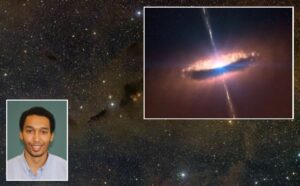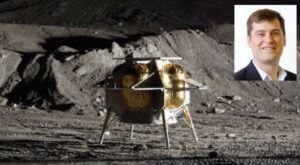Time: Sep 10, 2021 07:30 PM Eastern Time (US and Canada)
Join Zoom Meeting
AAAP Monthly Meetings
AAAP January Meeting
General Business Meeting
Guest Speaker and Topic: Ryan Muzzio presents “Young Stellar Objects: The Opening Chapter in the Life of a Star”
AAAP meetings are always free and open to the public. This meeting will take place at the Allegheny Observatory. Parking is also free.

Additional Information:
The AAAP starts the New Year with a sure-to-be fascinating lecture on the early life of stars. We tend to think of stars as very old, but all stars start out as infants and toddlers, so to speak. Our guest speaker for the club’s January 11, 2018 meeting is himself a young star [Read more…] about AAAP January Meeting
September’s Meeting features “Making the Moon Accessible to the World” by John Thornton

September 14th’s business meeting at the Carnegie Science Center will feature guest speaker John Thornton, the CEO of Astrobotics. Mr. Thornton’s talk “Making the Moon Accessible to the World” will describe the company’s payload services to the Moon’s surface for the federal government, foreign governments, companies and universities.
Featured Speaker Bio: John Thornton has grown Astrobotic’s business of delivering affordable space robotics technology and planetary missions by attracting technology contracts, equity investment, and payload customers. Thornton is coordinating the team and alliance for Peregrine’s development and the first mission. At Carnegie Mellon, Thornton led the build of Scarab, a NASA concept robot for lunar drilling, and the first robot to carry a prototype of NASA’s RESOLVE payload. He founded Carnegie Mellon’s Advanced Composites Lab, a research, training, design, and manufacturing lab specializing in high performance, lightweight composites for robotics.”
Our usual meeting room, the Bayer Science Stage, is already booked that night, so our friends at the CSC have invited us to hold our meeting in the Buhl Planetarium. When you arrive, go to the ramp in the main lobby that takes you up to the second level. Tell the nearest CSC staffer that you’re attending the Amateur Astronomers’ meeting in the planetarium. The meeting starts promptly at 7:30 pm. After that the planetarium doors are locked from the outside and you will not be able to enter until the meeting break.
Notes: Time permitting, it’s possible the Buhl staff will put on a few demonstrations of the planetarium’s projection systems and graphics after the meeting. Also, check out the massive remodeling done in the CSC’s main lobby…impressive. The meeting starts promptly at 7:30pm!
New Horizons: Pluto and Beyond, by NASA Mission Specialist Mark Kochte, 7:30 PM, May 11, 2018, Amateur Astronomers Association of Pittsburgh May Meeting and Speaker Presentation
Amateur Astronomers Association of Pittsburgh will hold the May Meeting and Speaker Presentation at 7:30 PM, May 11, 2018 at the Science Stage, Carnegie Science Center, 1 Allegheny Ave, Pittsburgh, PA 15212. The meeting lecture is free and open to the public. AAAP is excited to welcome back the most popular Mark Kochte, NASA Mission Specialist with the New Horizons Mission out of Johns Hopkins University Applied Physics Laboratory. This is one you do not want to miss. Mark will update us on the New Horizons Mission to Pluto and the upcoming invitation to spend New Year’s Day, January 1, 2019 with the NASA’s New Horizons visit to distant Kuiper Belt Object 2014 Mu69, 44.2 a.u. from the Sun. Mark shares the behind the scene information that along with his excellent presentation skills make his talks stand out. Be there on Friday to participate in the question and answer and to talk with Mark before and after his presentation. The presentation will be at the top of the evening followed by a break before the business meeting. The annual election of officers is held at this meeting. Members be sure to cast your vote. Afterwards, as always, those interested gather at Max’s on the North Side. Updates here and on AAAP’s Facebook Page. (Note: $5 per vehicle charge for use of parking lot.)
AAAP Meetings Planned for April 13 and May 11, 2018 Carnegie Science Center
The remaining AAAP spring meetings prior to the annual summer hiatus are scheduled for Friday, April 13, 2018 and Friday, May 11, 2018 at the Carnegie Science Center Science Stage. The speaker presentations are at 7:30 p.m. Weather-permitting look for an announcement on possible rooftop stargazing prior to the speaker presentation. The monthly members business meeting follow the break after the speaker.
Recall the Gravitational Wave announcement 2017 October 16th, the advanced LIGO and Virgo gravitational wave observatories announced the discovery of a new type of gravitational wave signal, caused by the collision of two neutron stars. The gravitational wave event occurred on 2017 August 17th, and was accompanied by a gamma-ray burst. NASA’s Swift satellite quickly maneuvered to look at the object with its X-ray and UV/optical telescopes. The spacecraft saw no X-rays – a surprise for an event that produced higher-energy gamma rays. Instead, it found a bright and quickly fading flash of ultraviolet (UV) light. This bright UV signal was unexpected and revealed unprecedented details about the aftermath of the collision. The short-lived UV pulse likely came from material blown away by the short-lived disk of debris that powered the gamma-ray burst. The rapid fading of the UV signal suggests that this outflow was expanding with a velocity close to a tenth of the speed of light. The results of the Swift observations were published in the journal Science. The discovery of this powerful wind was only possible using light, which is why combining gravitational waves and light in what is called ‘multi-messenger astronomy’ is so important. Credit: NASA/Swift
Our April 13, 2018 speaker is Mike Siegel, PhD the Ultra Violet Optical Telescope Lead on the Swift Telescope, recently renamed the Neil Gehrels Swift Telescope. He will talk to us about the Swift Telescope, what it can see, mainly x-ray or higher energies and how it operates. NASA’s Swift mission is dedicated to studying the gamma-ray burst/black hole connection. In an automatic mode the Swift is able catch gamma ray bursts, as well its three main instruments can be aimed at objects of interest including black holes, comets, bright stars, distant galaxies, etc.
May 11, 2018 brings us Mark Kochte, NASA New Horizons Mission Specialist to talk with us about, Pluto and Beyond. He will update us on the New Horizons Mission to Pluto and the upcoming invitation to spend New Year’s Day, January 1, 2019 with the NASA’s New Horizons visit to distant Kuiper Belt Object 2014 Mu69, 44.2 a. u. from the Sun.
Please join us at these presentations, which are free and open to the public.
AAAP Meeting, March 9, 2018, “Storms in Space – Ion Dynamics in the Earth’s Magnetosphere and It’s Implications on Earth” by Amy Keesee, PhD
Update: Due to the weather there will be no 6:30 PM Rooftop Stargazing. The AAAP Meeting convenes at 7:30 PM inside the Science Stage. There is another group meeting at 7 PM inside the Science Stage for a brief orientation.
We wish to extend a warm welcome to AAAP members, guests, AAAP Facebook Fans, Wagman Star Party Fans, Mingo Star Party Fans, etc.! Join us as we kick-off the 2018 Astronomy Weekend with a pre-meeting Meet & Greet with Roof Star Gazing at 6:30 PM (weather-permitting) at the Carnegie Science Center Planetarium-Rooftop Observatory, 1 Allegheny Ave, Pittsburgh, PA 15212. Members may bring their telescopes. The meeting starts at 7:30 PM in the Planetarium. AAAP members remain for the business meeting after the lecture.
The meeting presentation features Dr. Amy Keesee, a Research Associate Professor in the Physics and Astronomy Department at West Virginia University. Dr. Keesee’s research focuses on ion dynamics in the Earth’s magnetosphere. As a member of the NASA TWINS Mission of Opportunity Science Team she studies ion heating during geomagnetic storms using Energetic Neutral Atom data from the TWINS and the MENA (from previous NASA IMAGE Mission) instruments. Additionally she works in Dr. Earl Scime’s Lab, using laser-induced fluorescence to understand ions and neutral atoms in helicon source plasmas. Through a collaboration with NASA IV&V Educator Resource Center she teaches workshops and a summer course for pre-service and in-service educators to learn about Sun Science and Space Weather using iPads. She is very involved with the West Virginia Chapter of the Association for Women in Science. Dr. Keesee has three sons she is raising in Bridgeport, WV where her husband is a hospitalist internal medicine doctor. Get ready to enjoy a talk on delving into current NASA heliophysics research on Sun activity at an ionic level and its implications to Earth as well as how school age children can learn Sun Science and Space Weather.
These AAAP events are free and open to the public. There is a $5 Parking Lot Fee.
